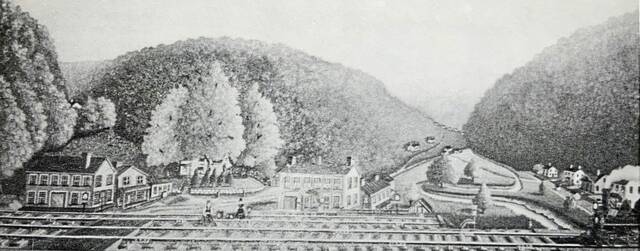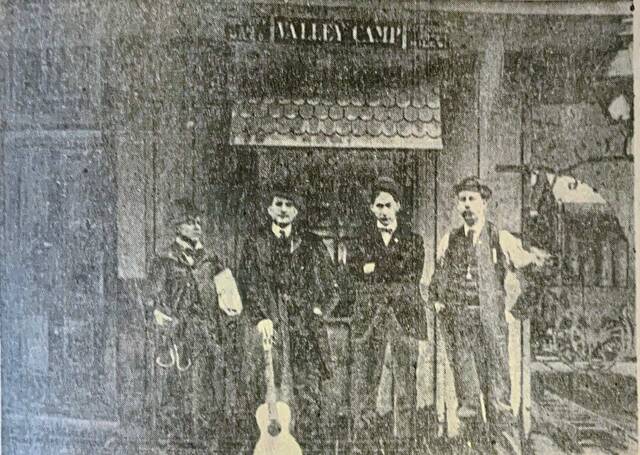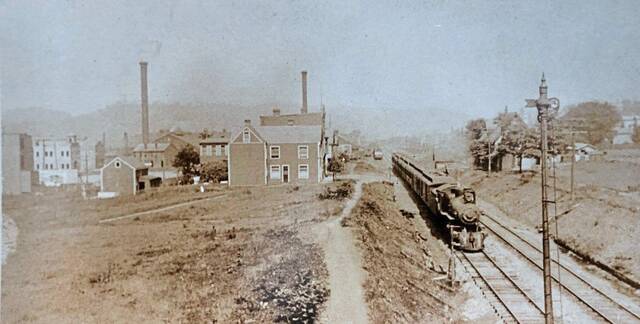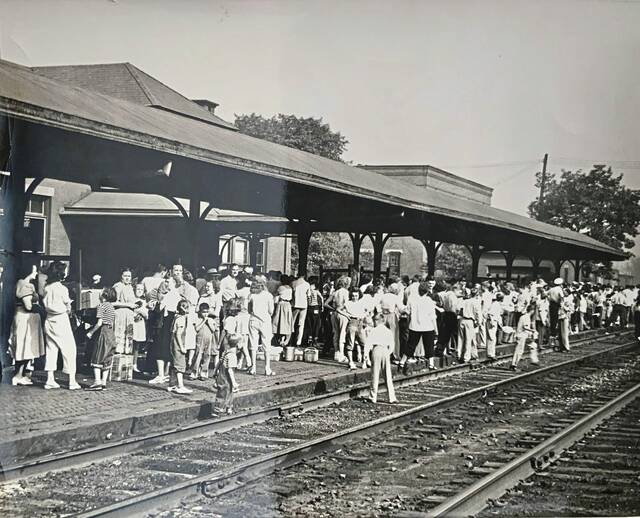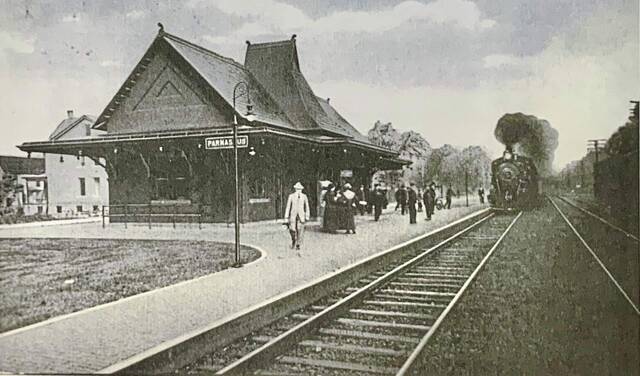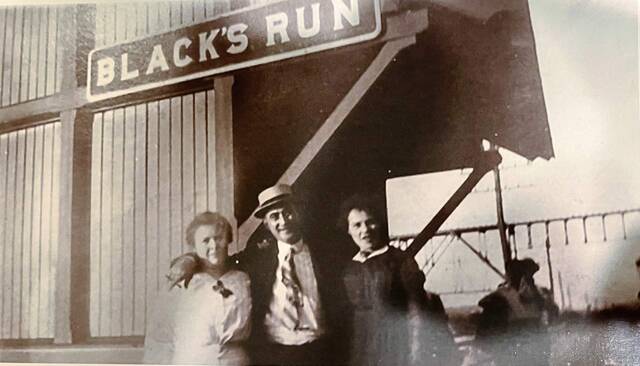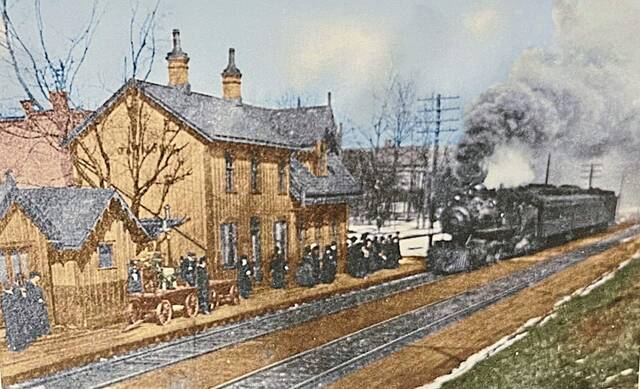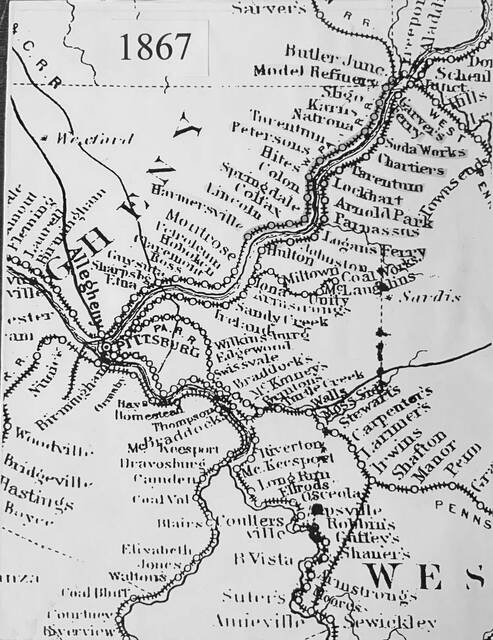Remember When: Numerous train stations dotted Allegheny Valley Railroad route from Braeburn to Oakmont
The Allegheny Valley Railroad, which ran along the Lower Burrell side of the Allegheny River, was the first major rail line to open in the Alle-Kiski Valley.
When completed in January 1856, the rail line extended from Pittsburgh to Kittanning. There were numerous train stations, or depots as they were referred to back then, constructed along its route.
Local historical societies have photographs of many of these stations, but there are a number for which no photographs are known to exist.
Hop onboard for a trip from Braeburn to Oakmont.
Soda Works Station
On a journey from Braeburn to Oakmont, passengers would see many stations. An 1867 map of the railroad line shows a station called “Soda Works” located slightly upriver from the present location of Lock and Dam No. 4.
This station was constructed before the founding of Braeburn Steel, and it most likely was located on the property the mill now occupies.
Braeburn and Natrona were famous for their salt wells, hence the name Soda Works. There is no known photograph of this station.
Braeburn Station
After the late 1890s, the next station one encountered while traveling toward Pittsburgh was the Braeburn Station.
It was adjacent to Braeburn Steel, which opened in 1898, and the train station probably was constructed about that time. The station was razed in 1957.
Chartiers (Edgecliff) Station
After leaving Braeburn, the train would arrive to Chartiers Station, also known as the Edgecliff Station.
This station was near where the Chartiers Run empties into the Allegheny River. A small town was once located there. The train station, constructed in 1856, also was the site of the first post office in Lower Burrell.
There are no known photographs of this station. There is, however, a painting by Charles Bryan showing the station. A copy of this painting has been included in several publications on the history of Lower Burrell.
Bryan’s painting depicts several figures and a child with their suitcases standing along the tracks with the station in the background.
Craigdale Station (later renamed Renoulf’s Beach Station)
After departing Chartiers Station, one would arrive at Craigdale Station.
In the mid-1800s, Craigdell Road, which is behind Giant Eagle on Tarentum Bridge Road, extended all the way down to the river. This station was at the base of Craigdale Road.
It was built in 1856 and had a variety of names over its lifetime. It initially was called Tarentum Station because passengers wishing to travel to Tarentum would exit the train at this point and take a ferry across the river to Tarentum.
Some years after rail traffic became available on the Tarentum side of the river, the name of the station was changed to Craigdale Station.
In the 1920s, the station was again renamed. It was called Renoulf’s Beach Station after the immensely popular swimming area located next to it. There are no known photographs of this station only photographs of the buildings at Renoulf’s Beach adjacent to it.
Arnold Park (Valley Camp) Station
The next stop on the railroad line was Arnold Park Station, also known as Valley Camp Station.
In the late 1800s, Valley Camp was a small community of elegant Victorian summer cottages. There is only one known photograph of this station taken in 1907 showing four men, one with a guitar, standing on the platform outside waiting for a train.
The station building stlll exists and is now a rental property belonging to Mark Gatto.
Arnold Station
The next station on the line was the Arnold Station. It was a beautiful structure located near the current Roosevelt Park.
The station also served as a home for the station master. All trains, including express trains, passing through had to stop and sign a registry at Arnold Station.
New Kensington Station
After the founding of New Kensington in 1893, the next stop for the Allegheny Valley Railroad was the New Kensington Station.
This was a very busy station especially during the boom years. There were numerous cabs stationed there to transport passengers to the local places of employment and businesses.
This structure was razed in 1958.
Parnassus Station
After leaving New Kensington, the next stop was Parnassus Station.
This station predated the station at New Kensington by more than 30 years.
The Parnassus Station also was famous because it was the site of the market train. Farmers could bring their livestock and goods to this location to transport to and from the markets in Pittsburgh.
Logans Ferry Station
The next stop was Logans Ferry Station, which was adjacent to the tracks in the area that currently houses a used car lot at the base of Coxcomb Hill.
Barking and Black’s Run stations
There were two train stations between Logans Ferry and Oakmont. They were at Barking and Black’s Run.
There are no known photographs of the Barking Station and only a photograph showing a partial view of the front of the Black’s Run Station.
Hulton Station
As you entered Oakmont, the first station you’d encountered was the Hulton Station.
It was built in 1853 and was the site of Oakmont’s first post office. It was located near the current Hulton Bridge Road.
It closed in 1933, and the building was moved to East Oakmont to be used for storage. In the 1950s, this structure was destroyed in a fire.
Upper Edgewater Station
The original Oakmont Station was an ornate Victorian building with board and batten siding. It was named the Upper Edgewater Station.
It was built about in 1880 and located at Maryland Avenue and Allegheny Avenue, across from the current location of Brr-kee’s Ice Cream Shop.
The station building was later moved to the corner of Archie Street and Cedar Way in Oakmont and converted into a house. This structure was demolished in 2005.
Oakmont Station
The last Oakmont Station was located near Hoffstots Restaurant.
It opened in 1904 and was used until rail service was discontinued in 1965. It was razed in June 1970.
Remove the ads from your TribLIVE reading experience but still support the journalists who create the content with TribLIVE Ad-Free.


